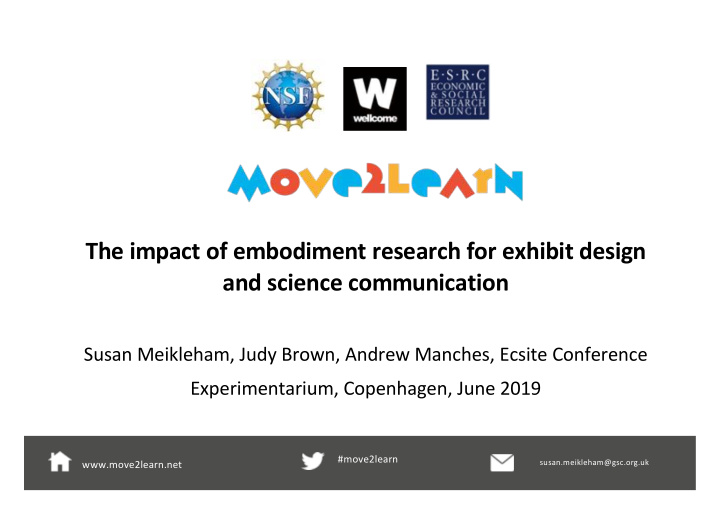



The impact of embodiment research for exhibit design and science communication Susan Meikleham, Judy Brown, Andrew Manches, Ecsite Conference Experimentarium, Copenhagen, June 2019 #move2learn susan.meikleham@gsc.org.uk www.move2learn.net
Move2Learn is a UK-US collaborative project investigating how the integration of certain movements into the design of science centre exhibits and facilitation can enhance science learning for early learners. #move2learn susan.meikleham@gsc.org.uk www.move2learn.net
Striving to Develop a practitioner/researcher interaction model that will • strengthen collaborations Understand the role of embodied interaction in young • children’s (ages 3-6) learning about science. Inform the intentional design of science exhibits and • communication #move2learn susan.meikleham@gsc.org.uk www.move2learn.net
Project Overview 2018 STEM For All Video Showcase http://videohall.com/p/1199
A Game #move2learn susan.meikleham@gsc.org.uk www.move2learn.net
Session Goals Learn more about embodied learning • Set the context for our research collaboration • Try out some tools in development • #move2learn susan.meikleham@gsc.org.uk www.move2learn.net
Cognition Where is this child’s cognition (thinking)? #move2learn susan.meikleham@gsc.org.uk www.move2learn.net
Embodied Cognition Don’t think of cognition (thinking) as something static stored in brain Do think of cognition (thinking) as a dynamic activity involving our bodies, others and the world around us #move2learn susan.meikleham@gsc.org.uk www.move2learn.net
Thinking and Learning – evident in our ‘ embodied interaction ’ #move2learn susan.meikleham@gsc.org.uk www.move2learn.net
Why does this matter? • We have a new window into how we think about science ideas • We can recognize more diverse ways that children communicate their understanding • We can inform the design of hands-on experiences, and even use emerging technologies that can respond to our actions • We can inform the way we communicate to children #move2learn susan.meikleham@gsc.org.uk www.move2learn.net
Our Research Questions 1. In what ways can embodied interaction represent scientific thinking? 2. How can we improve embodied interaction to support children’s science thinking? 3. How does embodied interaction relate to children’s enjoyment of exhibits? 4. How do families influence children’s embodied interaction? 5. What, if any, socio-cultural differences exist in children’s and/or their families embodied interaction? #move2learn susan.meikleham@gsc.org.uk www.move2learn.net
Diverse Settings and Exhibits Computer Simulation – Single User The Children’s Museum – Indianapolis, IN #move2learn www.move2learn.net susan.meikleham@gsc.org.uk
Full Body Immersive Frost Science, Miami FL #move2learn susan.meikleham@gsc.org.uk www.move2learn.net
Multi-user Hands-On Interactives Glasgow Science Centre, Scotland #move2learn susan.meikleham@gsc.org.uk www.move2learn.net
Common Goal Affirming and supporting family interactions that can impact learning opportunities for all children! #move2learn susan.meikleham@gsc.org.uk www.move2learn.net
Multi-site Data Collection Do differences matter when it comes to understanding data 1. collected across diverse sites? 2. Participant population differences 3. Environmental differences Single vs multiple user exhibits • • Prescribed gesture ( e.g. pointing) vs open • Duration of experience • Signage • Location of exhibit #move2learn susan.meikleham@gsc.org.uk www.move2learn.net
Toolkit Videocoding and Analysis Schema Interview protocols Exhibit Analysis Design Attributes Embodied Interaction Adult Parental Attitudes Learning Scaffolding Tool Science ( PALS) Survey #move2learn www.move2learn.net
Adults’ embodied scaffolding: work in progress #move2learn www.move2learn.net
Practice Time • Watch the clip • Note down what you find interesting about the clip • Share your observations #move2learn susan.meikleham@gsc.org.uk www.move2learn.net
#move2learn susan.meikleham@gsc.org.uk www.move2learn.net
Practice Time • Watch the clip again • Use the practice sheet • Share your observations • How might this data help you? #move2learn susan.meikleham@gsc.org.uk www.move2learn.net
Adults’ embodied scaffolding: Ecsite 2019 Pilot Practice #move2learn www.move2learn.net
#move2learn susan.meikleham@gsc.org.uk www.move2learn.net
Practice Time • Watch the clip • Note down what you find interesting about the clip • Share your observations #move2learn susan.meikleham@gsc.org.uk www.move2learn.net
Practice Time • Watch the clip again • Use the practice sheet • Share your observations • How might this data help you? #move2learn susan.meikleham@gsc.org.uk www.move2learn.net
#move2learn susan.meikleham@gsc.org.uk www.move2learn.net
How can this work inform exhibit design / facilitation? Design Based Research #move2learn susan.meikleham@gsc.org.uk www.move2learn.net
Re-design: Balance Exhibit and Facilitation in Glasgow #move2learn susan.meikleham@gsc.org.uk www.move2learn.net
Reflections What could be the implications for your exhibits/ facilitation? #move2learn susan.meikleham@gsc.org.uk www.move2learn.net
Thank you! www.move2learn.net #move2learn a.manches@ed.ac.uk www.move2learn.net
Resources https://www.online-stopwatch.com/countdown- clock/full-screen/ www.move2learn.net #move2learn a.manches@ed.ac.uk www.move2learn.net
Recommend
More recommend